Story at a glance:
- The CEO of a growing sustainable community is proving that developers and preservationists can work together and win.
- Serenbe Founder Steve Nygren shares what it takes to design a sustainable community—and why it’s needed more than ever.
- The English countryside served as a model for Serenbe, emphasizing high density development surrounded by as much preserved land as possible.
Steve Nygren didn’t set out to be a developer, much less the unofficial king of a growing sustainable kingdom. “I had sold my hospitality company and we retired to the country to raise our kids and do what we wanted to. I was lucky enough to do that,” he says.
When he realized there was an opportunity to live not far from the urban sprawl (with easy access to the rest of the world via the Atlanta airport) but far enough to feel a world away, he jumped at the opportunity to buy farmland on the edge of Atlanta. Developers weren’t interested at the time, he says, because the area had no schools, no amenities. At the turn of the 21st century, land was cheap. “In 2000 it became obvious that development was headed our way because it was the last available land in metro Atlanta,” Nygren says. “I started buying land and, at 900 acres, I couldn’t keep doing that.” He started to get others involved.
What started simply as his own home is now a vast neighborhood focused on well-being. Nearly two decades after the Nygren family moved, Serenbe has become a highly sought-after walkable community with instant forest access, more than 1,000 residents, and a bustling social calendar. Serenbe the community officially broke ground with its first house in 2004, and Nygren and his team filed to make the area a city—Chattahoochee Hills—in 2007. They even have their own school with more than 200 students enrolled. “More than 300 kids live at Serenbe—not one recorded case of asthma,” Nygren says of the health benefits of living in nature.
gb&d recently spent a weekend on the grounds, complete with neighborhood tour via golf cart and meditative walk through the trees. We marveled as we saw kids bounce on an in-ground trampoline and run barefoot through pedestrian-friendly streets; parents grabbed a coffee at the coffee shop and played tennis. There seemed to be much to do—at your own speed—at Serenbe.
Here is just some of our conversation with Nygren.
How do you create an environment like Serenbe?
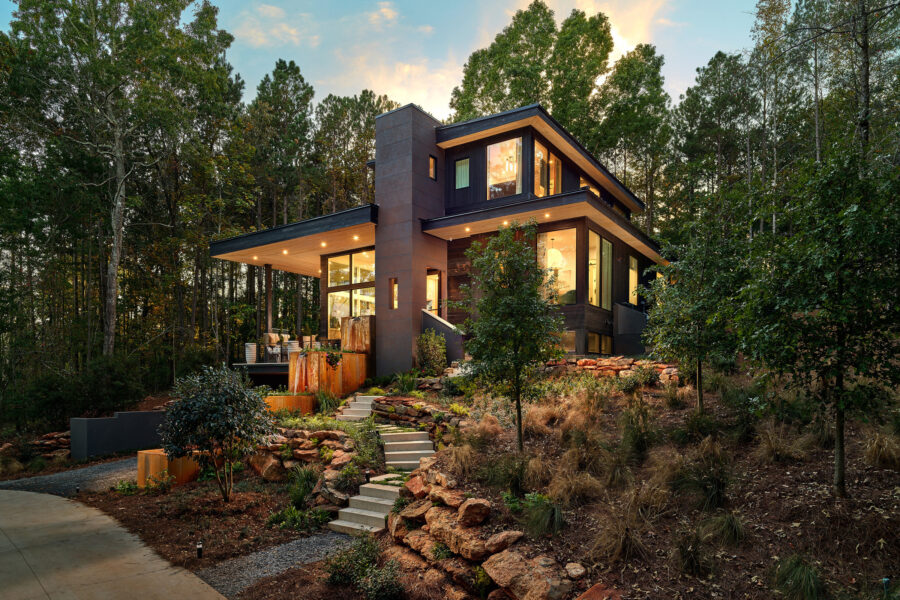
Varied architecture is found throughout Serenbe and all homes are geothermal, but each house must commit to one architectural style. Photo courtesy of Serenbe
Once I realized I was going to be a developer, I really started thinking about the places I responded to and some of the ills of our current built environment.
We led an effort to bring a community together—both pro-development and pro-preservationists for a common vision—and we created our own zoning on 40,000 acres. That then became a city because it was different zoning than metro Atlanta. We broke ground on our own land to prove that this concept of biophilic, balanced growth worked.
We can develop without destroying nature.
I did this to prove that we can develop without destroying nature. That was the number one principle I started with: How can we save 50% of the land? Well, we’re going to save 70%, and we’re going to put more density.
We used the countryside of England as our model, because after World War II they put good land laws in. There are a lot of people in villages and towns that are still very rural when you drive outside of London.
What makes a true community?

The first house at Serenbe was built in 2004, and today the community is home to more than 1,000 residents. Photo courtesy of Serenbe
The first thing is art. If you look at the great places across centuries, wherever we went in America or Europe, there was always an art patron. There was someone who saw that as important—and beauty in architecture.
Over the last five decades we’ve gotten into efficiency and value engineering. A lot of things we’re building don’t really speak to art. We’ve worked to make places for art galleries, and we commissioned artists to do our streetlights, our trash cans, and our benches.
We have artists here throughout the year. This was all part of the vision from day one, before we broke ground.
Number two is food. We have to understand our agriculture. We have become “big ag.” No one understands the seasonality of food. They don’t know who their farmer is or where their food comes from.
We wanted to have an organic farm right next to the houses. That hasn’t been done in decades. In fact, it’s standard to put housing as far away because we think it’s smelly. Well, industrial agriculture is smelly, but organic isn’t. So we have the farms, and people know their farmers, and we have the markets.
We’re in a food forest, and our kids understand the seasonality of food.
But it’s not just the farms. The crosswalks are all blueberry bushes, and there are nut trees and apple trees. We’re in a food forest, and our kids understand the seasonality of food.
Third is wellness. We’re deep in the middle of that now. We’ve broken ground on our wellness community, for starters.
They say we [as a society] are in the business of hospitals, but that means we’re in the business of keeping people sick. We’ll be announcing before long an innovative wellness campus for aging in place that shines a light on how dysfunctional our medical institution is.
Some conscious people are leaving those institutions, and we’re setting up our own. I was lucky because I had success in hospitality and real estate in the city so I could do this. I went ahead and built a 2,300-square-foot building no one thought anyone would need, let alone health professionals. Today it’s totally filled with health professionals.
How does where people live factor in?

The Blue Eyed Daisy is one of the popular retail storefronts at Serenbe. Photo courtesy of Serenbe
We have what we call live/work, where the retail is on the street and you have two apartments above it—something that has all but disappeared. It was very common in the 1930s. We now have 18 of those live/work, and most of them are occupied with some sort of health services—from Pilates to a small animal vet, cold pressed juice, and so on.
We also have a martial arts place, an ice cream shop, a bagel shop, an interior design storefront, a pottery shop. We have all of these interesting people. Just by putting out the intent and moving forward, people are showing up.
We’re becoming a real valley of health. Other global organizations are buying land down the road from us, and we’re going to see a lot more coming out. We are going to become known as a destination for vital well-being.
How does where you live impact your lifestyle?
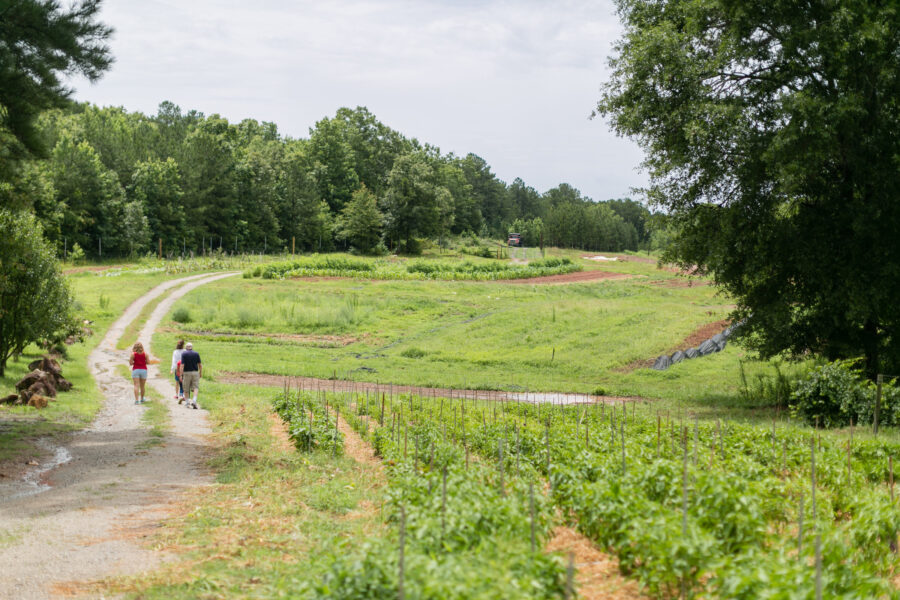
The vision for the community of Serenbe was born in an effort to protect the beautiful rural land just outside of Atlanta known as Chattahoochee Hill Country. Photo by J. Ashley
People who move here tell me that they gave up diets years ago and suddenly they’re losing weight. People who share that their kids were having behavior problems and moved here, all that’s gone. We’re looking to one of the universities to start control groups to measure when people move in and their lifestyle changes.
Our built environment causes a lot of the big problems that are dysfunctional. We’re obese, we’re depressed, we’re spending more money than we should to try to be well and fix ourselves, and it has to change.
Our built environment causes a lot of the big problems that are dysfunctional.
Education is our core. Art, agriculture, well-being, and education are our four pillars, and then balancing nature and each other—connecting viability. This was from the philosophy that we launched 20 years ago, and that has not changed.
How do you achieve authentic placemaking?
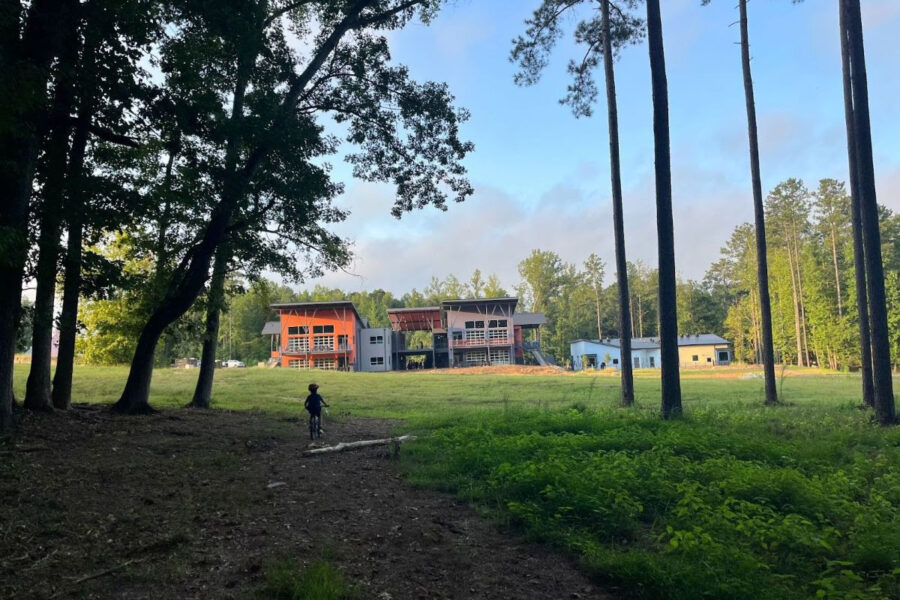
More than 300 kids attend schools at Serenbe. Photo courtesy of Serenbe
Starting out people thought I was crazy. When my friends from the hospitality industry found out I was going to put the Blue Eyed Daisy, the first restaurant/coffee shop, in what was then the middle of the woods, they thought I was absolutely nuts. They said, “Why don’t you put it on the Main Street so people can find it?” I said, “I’m doing this because I’m creating a place and you have to have these places people can gather and that are destinations.”
We now have 60 business licenses at Serenbe, according to the city. We don’t yet have the households to support 60 businesses, but we have created a place and people are coming here supporting those businesses. That’s what placemaking means. We have people moving to Serenbe who never thought they’d live in the South. That’s because of the place we’ve created.
Luckily we’re 25 minutes from the busiest airport in the world. That helps, but it’s that combination that isn’t happening necessarily in metro Atlanta. You have other people moving here because they want the place.
What are the rules around home design and construction at Serenbe?
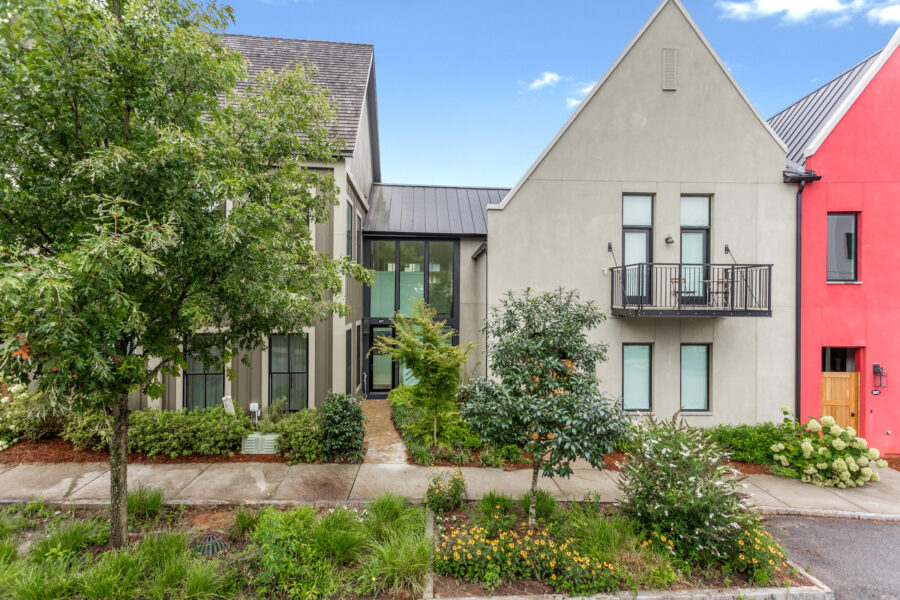
Serenbe is divided into various neighborhoods, including one inspired by Scandinavian architecture. Photo courtesy of Serenbe
When we’re developing a new area we have what we call Builder Spec Houses. That’s where the builder is going to buy a group of lots, build them, and resell them for us.
We bring in a team of architects and we predesign the entire street. We bring a colorist in, and we decide what paint color they all are.
Then we sell those to each group of builders—a group of anywhere from four to 20 lots could go to a builder who’s going to take those, build them, price them, and resell them.
We also have what we call retail lot sets. That’s where we’ll sell a lot directly to a buyer. They can bring in their own architect and their own builder; they just have to be environmentally certified. For those we have what we call lot condition sheets that detail where the house sits in relation to the curb, the massing, how tall the house is, and how much of the lot it occupies in the width of the street.
What about the varied architectural styles?
Each house has to be one style of architecture. We include varied architecture from lot to lot, but you can only have one style of architecture per lot. It’s amazing how simple that is and yet how complicated. Each architect has to defend the style, and then of course it’s a client usually who they’re working for, and many times they’ve taken cell phone pictures of all these things they like, but they don’t know that the windows and the gables and the door they like maybe aren’t one architectural style.
That restraint is why I think everyone comments about how it’s good architecture. There are punctuations, but overall it’s not overly busy. It fits together. We really focus on placement, mapping, and quality.
How is the development committed to sustainability?
We conserve energy by facilitating geothermal, solar, and net zero homes. We conserve water with native and edible landscaping and naturally treating our wastewater for reuse as irrigation.
Serenbe land planning protects the wetlands, and historic zoning preserves the majority of the land as green space, with respect for the agricultural history of Chattahoochee Hill Country.
We do all geothermal.
How has access to nature and preservation evolved?
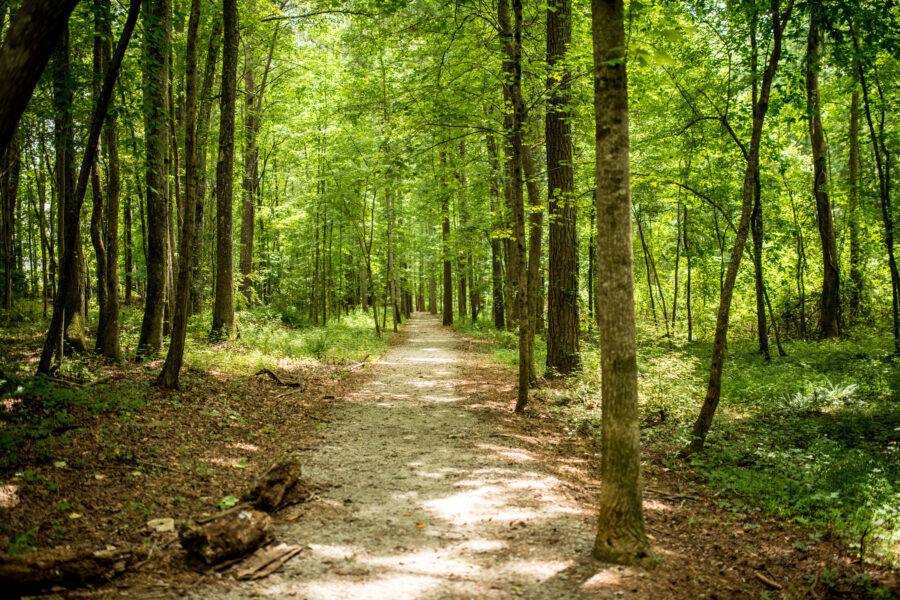
Plentiful trails wind residents and visitors alike from neighborhoods or the inn through the forest at Serenbe. Photo couresy of Serenbe.
We’re extending our property and farmettes to the west, which takes us another mile-and-a-half closer to the Chattahoochee River. We’re putting more trails in, so we’ll be able to walk all the way to the Chattahoochee River, which, from the Blue Eyed Daisy is about four miles, and we stretch a mile-and-a-half through our farmettes. This trail connectivity is larger.
We’re working with the Trust for Public Land, and there is a whole effort now to put the trails up along the river. We will eventually be able to bike from here into the center of Atlanta—all through nature.
What are other benefits—including financially?
I said 20 years ago, environmental groups, biophilic groups, whoever—I felt we were a bunch of people carrying lanterns in the darkness trying to find one another. Suddenly, post-pandemic, we’re walking into lighted rooms.
There is an awareness about so many of these issues. I recently spoke at a Global Wellness Summit. Ten years ago when they invited me to their annual convention to talk about what wellness real estate meant I was the only developer from any country. Now it has changed so much that it’s a completely separate day-and-a-half conference of only real estate-focused people held at JPMorgan Chase on Madison Avenue. In 10 years, but primarily the last three years, there’s been huge change.
You’ve got major corporations saying they’re devaluing property that does not have a path to environment and wellness principles.
Wellness real estate is something no one thought was a thing 10 years ago, and now you’ve got major corporations saying they’re devaluing property that does not have a path to environment and wellness principles.
How did zoning have to evolve for Serenbe?
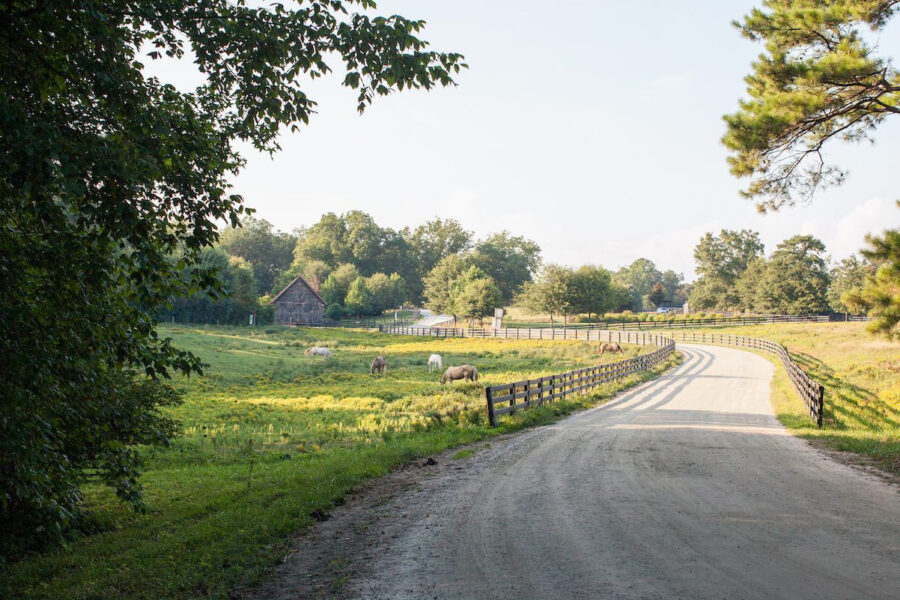
An extensive trail network, a stable full of horses, and organic farms are all part of the community at Serenbe, just outside of Atlanta. Photo courtesy of Serenbe
This was 40,000 acres of unincorporated land. It still has agricultural zoning on it. It is in Fulton County, which is the county that also includes Atlanta, but Atlanta is its own city, and that city zoning applies to Atlanta.
We were initially an overlay in 2002 in the county, but then we filed the state legislature to become our own city. Because of Serenbe’s projected growth we could guarantee a tax base. Previously this was an underfunded rural area that could not support public safety services; the taxes weren’t here. We are now 60% of the taxes for the entire city—with full-time fire, full-time police, and full-time public works. We have been able to roll property taxes back twice.
We’re going to bring higher property values to the pro-development people, and we’re going to save more land than any metro area.
As their values raise, we roll the taxes back on farmland and affordable housing as their values raise so the taxes don’t get crazy. Either through Serenbe or we have our own city—we have an elected mayor, we have elected City Council—we brought the entire community together and created this vision and approved the zoning tools that would allow that to happen.
This is pro development and pro preservation. Everyone understands what we’re going to give each of them; we’re going to bring higher property values to the pro development people, and we’re going to save more land than any metro area in the United States. Rather than these groups fighting each other, we’ve brought them together over food and desserts and coffee over two years. It’s that whole hospitality attitude. We’re just bringing people together: Let’s talk about the issues. And we did that, and we brought diverse groups together, and now we’re moving forward.
What does the future of Serenbe look like?
Serenbe now is 2,000 acres. We are paving the first section of street on our fourth major neighborhood section, Spela, which is Swedish for play. An important part of mental and physical health is to remember to play at all ages. We’re certainly going to bring that forward for our 80- and 90-year-olds to remind them.
If you saw our sign, it said: “Slow down. Children and adults at play.” We’re reinforcing this by building a community around a Victorian Park that will have everything from meditation gardens to incredible slides. It will have exercise equipment that is geared toward seniors out in the woods, plus trails and sandboxes. We’re doing sculptures, and we’re doing these incredible Victorian streetlights. I think people are going to smile when they see all this.
Why is this so important to you?
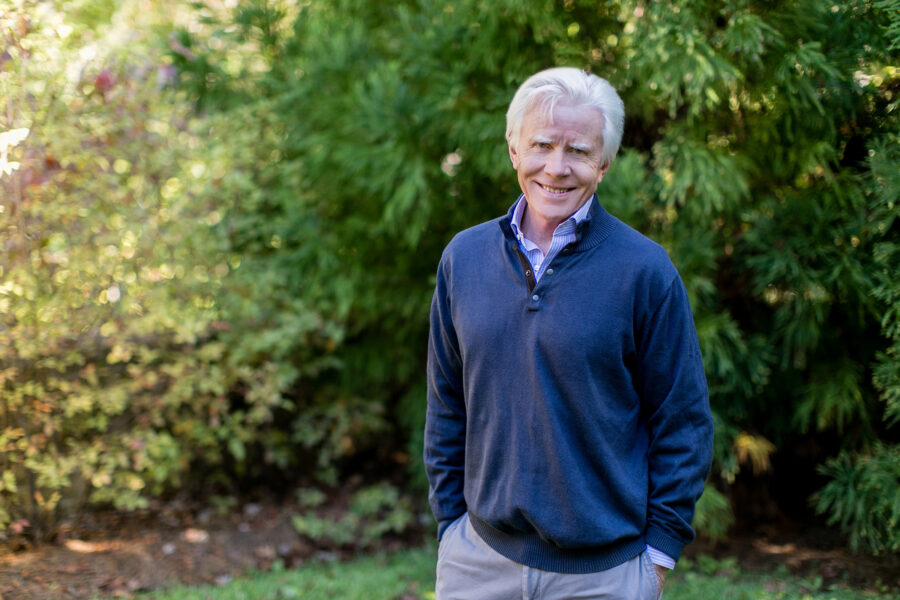
Steve Nygren is the founder and CEO of Serenbe, a wellness community just outside of Atlanta. Photo by J. Ashley Photography
I’m doing this for my grandkids, but more importantly, their grandkids who I’ll never meet. The decisions we make today will affect the lives they’re going to live.
I’m so appreciative of my ancestors who made the sacrifice to leave the Scandinavian famine and come to the New World—and what they gave up and sacrificed to do that.
If you look throughout history, it’s one person stepping up and going against the grain that changes the dynamics.
It’s possible to change the future of where we live. It takes one person dealing with their own backyard. And I define a backyard as any place you have influence.



